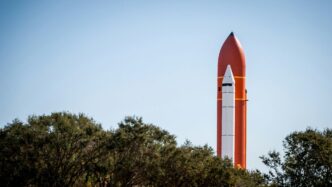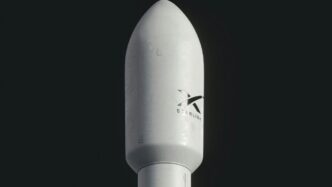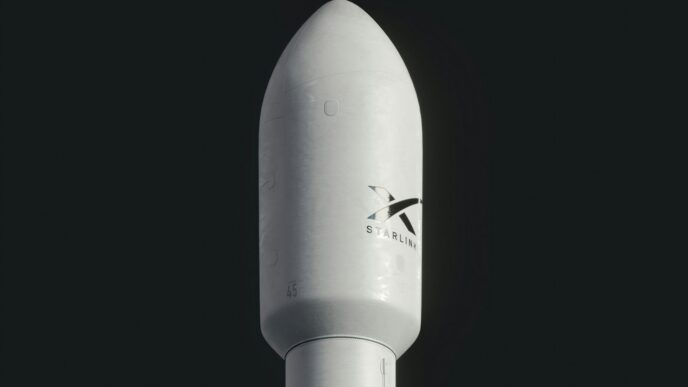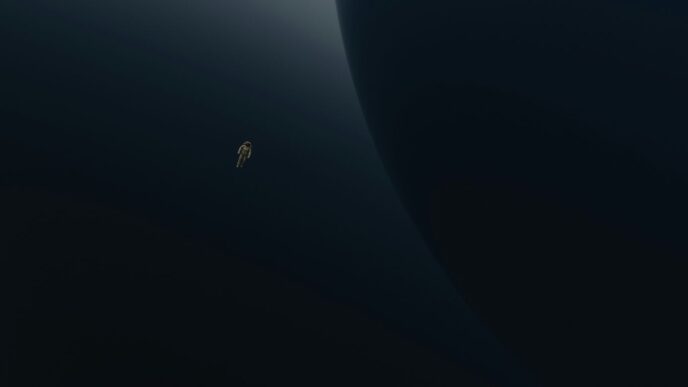Latest US Space News and Discoveries
MAVEN Mission Launched to Mars
It was on November 18, 2013, that NASA sent the MAVEN spacecraft on its journey to Mars. This mission was all about understanding the Red Planet’s atmosphere. Scientists wanted to figure out how Mars lost most of its water and atmosphere over billions of years. It’s a pretty big deal for figuring out if Mars ever had life. The data MAVEN has sent back has really helped us piece together the planet’s history. It’s amazing to think about how much we’ve learned just from one probe.
Euclid Space Telescope Captures Cosmic Cloud
The Euclid space telescope recently snapped a picture of a cosmic cloud that’s just stunning. This image shows off Euclid’s abilities, not just for looking at things close by in our own cosmic neighborhood, but also for peering way out into the deep universe. It’s a reminder of how much is out there waiting to be seen and understood. The detail in these shots is pretty incredible, giving us new views of nebulae and star-forming regions.
New Insights into Black Hole Physics
As our images of black holes get clearer and more detailed, scientists are starting to question if Albert Einstein’s theory of gravity, general relativity, is the whole story when it comes to these mysterious objects. It turns out, black holes might be more complex than we initially thought. New observations are pushing the boundaries of our understanding, and it’s possible we’ll need new theories to fully explain what’s going on at their event horizons. It’s a wild time for physics, that’s for sure.
Upcoming Rocket Launches and Spacecraft Updates
Keeping track of what’s blasting off and what’s new in space can feel like a full-time job, right? Well, good news! Things are really picking up.
Rocket Launch Schedule and Viewing Information
There’s always something heading skyward, and staying updated is key if you want to catch a launch. We’re seeing a steady stream of missions from various agencies and private companies. The FAA recently lifted its ban on daytime rocket launches, which means we can expect more frequent launches, especially from SpaceX with its Starlink constellation. This is a pretty big deal for getting more satellites into orbit faster.
Here’s a quick look at what to expect:
- Check Launch Providers: Keep an eye on the websites of major players like SpaceX, United Launch Alliance (ULA), and NASA. They usually have the most up-to-date schedules.
- Live Streams: Most launches are broadcast live online. Space.com often provides links to these streams, so bookmark their launch blog.
- Daytime vs. Nighttime: With daytime launches now permitted, you might have more opportunities to see rockets ascend, depending on your location and the launch site.
NASA to Unveil New Images of Interstellar Comet 3I/ATLAS
Get ready for some stunning visuals! NASA is set to reveal new images of the interstellar comet 3I/ATLAS. This comet is special because it originated from outside our solar system, giving us a rare glimpse into materials from other star systems. The big reveal is happening on November 19th at 3 p.m. Eastern Time. It’s always fascinating to see what these cosmic visitors can teach us about the wider universe. Make sure to tune in to the live broadcast if you can!
Celestial Events and Atmospheric Phenomena

Get ready for some amazing sights in the sky! This week is shaping up to be a busy one for stargazers and anyone interested in what’s happening above us.
Northern Lights Forecasts and Geomagnetic Storm Warnings
Keep an eye on the skies for the aurora borealis. We’re seeing some increased solar activity, which means there’s a good chance of seeing the Northern Lights even in areas where they’re not usually visible. Space weather forecasters are tracking potential geomagnetic storms. These storms can cause the aurora to appear further south than normal. It’s always a good idea to check the latest aurora forecasts if you’re hoping to catch a glimpse of this incredible natural light show. The intensity and visibility of the aurora depend heavily on the strength of these solar events.
Leonid Meteor Shower and Aurora Display Expected
Mark your calendars for the Leonid meteor shower, which is expected to peak soon. This shower is known for its fast meteors, and sometimes, it can put on a really spectacular display. Along with the meteors, there’s a possibility of another aurora display. It’s like a double feature in the night sky! Here’s what you might want to know:
- When to Watch: The Leonids are active for a while, but the peak viewing times are usually in the early morning hours, just before dawn.
- What to Expect: Look for bright, fast-moving streaks of light. While not every year is a ‘storm’ year for the Leonids, even a regular showing can be quite impressive.
- Aurora Bonus: If the geomagnetic activity is high enough, you might see the aurora dancing in the sky at the same time as the meteors. Talk about a cosmic treat!
Make sure to find a spot away from city lights for the best view. Grab a warm drink, some snacks, and enjoy the show!
Exoplanet Research and Galactic Exploration
New Discoveries Add to Exoplanet Menagerie
It feels like every week there’s news of another planet found way out there, beyond our own solar system. We’ve now confirmed over 6,000 exoplanets, and that number keeps climbing. Some of these worlds are pretty wild, like the "warm Earth-sized" planets recently spotted in the TOI-2267 system. It really shows you how diverse these distant worlds can be.
JWST Demand Hits New Peak
Getting time on the James Webb Space Telescope (JWST) is a big deal for astronomers. It’s the most powerful telescope we have, and after a long development, it’s been busy for almost four years. Now, heading into its fifth year, the folks who run JWST have received more requests for observation time than ever before. A bunch of judges and scientists are going through all these proposals to pick which ones get to use the telescope.
The Seven Sisters Cluster Reveals Thousands of Hidden Stars
Astronomers are using new techniques to look closer at star clusters. For example, they’ve been studying the Pleiades, also known as the Seven Sisters. Using advanced methods, they’ve found thousands of stars that were previously hidden from view. This helps us understand how stars form and evolve within these dense groupings. It’s like finding a whole new neighborhood in a place you thought you knew well.
Advancements in Space Exploration Technology
It feels like every week there’s some new gadget or gizmo making waves in the space world. Things are really moving fast, and it’s pretty exciting to see.
AI Powers Satellite Autonomy
So, artificial intelligence is showing up everywhere, and now it’s helping satellites fly themselves. We’re talking about satellites that can figure out how to adjust their position in space without a human telling them what to do every single step of the way. This is a big deal because it means we can do more complex things in orbit and react faster to whatever happens up there. Think about it: if a satellite can make its own decisions, it can avoid space junk or fix problems on its own. It’s a major step towards satellites being truly independent.
Lunar Dust Properties Updated for Future Missions
Anyone who’s followed space news for a while knows that moon dust is a real pain. It gets everywhere, it’s abrasive, and it can mess with equipment. Well, scientists have been digging into the details of this dust, updating what we know about its physical traits. This isn’t just academic stuff; it’s super important for anyone planning to build bases or send robots to the Moon. Knowing the exact properties of the dust helps engineers design better rovers, better suits, and better habitats that can actually survive on the lunar surface. It’s all about making sure we can actually use the Moon, not just visit it.
FAA Lifts Ban on Daytime Rocket Launches
Good news for rocket fans! The Federal Aviation Administration (FAA) has lifted a ban that stopped rocket launches during the daytime. This is a pretty significant change, especially for companies like SpaceX that launch a lot of Starlink satellites. Now that daytime launches are back on the table, we can expect to see more frequent launches. It just makes the whole process more flexible and efficient for getting things into orbit. It’s one of those regulatory changes that can really speed things up for the industry.
Cosmic Mysteries and Theoretical Physics
The universe is a big place, and sometimes it throws us curveballs that make us scratch our heads. Scientists are constantly trying to figure out how things work, and lately, there have been some head-scratchers coming from all corners of space.
Solar System’s Unexpectedly High Speed Through Space
Did you know our entire solar system is moving through the Milky Way galaxy at a pretty good clip? We’re talking about roughly 515,000 miles per hour (828,000 kilometers per hour). That’s fast! But here’s the weird part: some recent studies suggest we might be moving even faster than previously thought, or perhaps our path is a bit more erratic than we imagined. It makes you wonder what’s out there pushing us along, or if something is pulling us in a direction we didn’t expect. It’s like being on a highway and realizing you’re going faster than the speed limit, but you’re not sure why.
DESI Collaboration’s Findings on Dark Energy
Dark energy is one of those things that scientists talk about a lot, but nobody really knows what it is. It’s this mysterious force that seems to be making the universe expand faster and faster. The Dark Energy Spectroscopic Instrument (DESI) is a big project trying to map out a huge chunk of the universe to get a better handle on this stuff. They’ve been collecting a ton of data, and what they’re finding is starting to paint a clearer picture, though still a bit fuzzy around the edges. It’s like trying to understand a giant puzzle where most of the pieces are invisible.
Here’s a quick look at what DESI is trying to do:
- Map the positions of millions of galaxies.
- Measure how the universe has expanded over billions of years.
- Understand the properties of dark energy.
Explaining JWST’s Puzzling Early Galaxies
The James Webb Space Telescope (JWST) has been sending back some amazing images, but it’s also found some things that don’t quite fit our current models. Specifically, it’s spotted galaxies that appear to be much more developed and massive than they should be, given how early they formed in the universe’s history. It’s like finding a fully grown adult in a nursery. Scientists are working on new theories to explain how these galaxies could have grown so big, so fast. Maybe star formation was more efficient back then, or perhaps our understanding of how galaxies form needs a serious update. It’s a good problem to have, though – it means we’re learning new things about the cosmos.
The Search for Extraterrestrial Life
It’s a question that’s been around forever, right? Are we alone in the universe? Well, scientists are working hard to find out, and some of the latest ideas are pretty wild.
Microbial Rust as a Biosignature on Mars and Icy Moons
Think about rust. On Earth, it’s just metal getting old and corroded. But here’s the twist: on other planets, that same rusty stuff might be a sign of life. Scientists are looking at how tiny microbes on Earth use iron to live. They think similar processes could be happening on Mars or even on moons like Europa or Enceladus, which we know have liquid water oceans under their icy shells. If we find certain types of rust formations, it could be a big clue that something living is or was there. It’s like finding a fossil, but instead of bones, it’s a chemical signature.
Clouds as Potential Habitats for Life on Distant Worlds
We usually think of life needing a solid surface or liquid water, but what about clouds? Some scientists are exploring the idea that clouds on exoplanets – planets outside our solar system – could actually be good places for life to hang out. Imagine tiny organisms floating around in the atmosphere, getting what they need from the gases and sunlight. It’s a bit like how some bacteria live in Earth’s clouds. This is especially interesting for planets that might be too hot or too cold on their surface, but have a more temperate layer in their atmosphere.
Insects Considered for Space Menu
Okay, this one’s a bit different, but it’s still about life in space – or at least, supporting human life in space. When we send astronauts on long missions, like to Mars, they need food. Shipping all that food from Earth is a huge challenge. So, researchers are looking at alternative protein sources. And guess what? Insects are on the list! They’re packed with nutrients and are way more efficient to raise than traditional livestock. While it might sound a little strange to us now, eating insects could become a normal part of space travel in the future. It’s all about finding sustainable ways to keep humans alive and healthy far from home.
Wrapping Up Our Space Journey
So, that’s a quick look at what’s been happening out there in space. From new telescope images showing off cosmic clouds to figuring out how we might eat on Mars, it’s a busy time. We’re still learning about black holes and how fast our solar system is moving. It feels like every week there’s something new popping up, whether it’s a rocket launch or a weird new planet. It’s pretty wild to think about all this stuff happening way up there while we’re just down here. Makes you wonder what we’ll find out next, doesn’t it?














